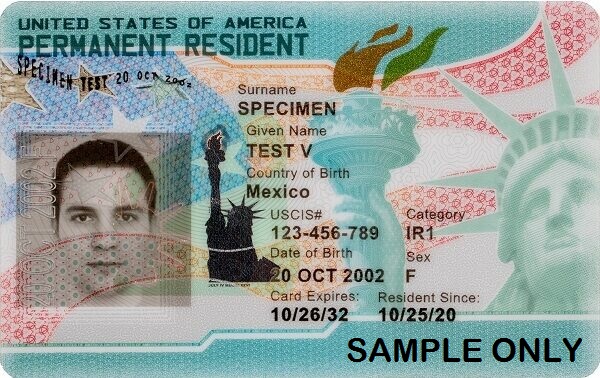Consular Processing Explained
Let Assess Your Profile
Get discovered by 8,000+ employers & apply to jobs in a single click Get Assess Your Profile For Citizenship In Australia, Canada & New Zealand.
Consular Processing, Explained
How to apply for a green card from outside the U.S.
Consular Processing and services Explained
Consular processing is the application process for a U.S. green card when applying from outside of the United States.
The application process for a green card varies depending on whether you’re already in the United States, or still in your home country. If you’re applying from your home country, your application will go through consular processing (also known as a CR-1 or IR-1 visa – more on that below), which simply means that it will be handled by your local U.S. Embassy or consulate.
Consular processing is different from Adjustment of Status (AOS), which is used when applying for a green card from inside the United States. With consular processing, you’ll have to wait in your home country until your U.S. green card is approved.
Both consular processing and AOS have their own timelines, application forms, supporting documents, and costs, but the overall green card eligibility requirements are identical. Applicants should check which process fits their individual situation.
This guide explains how to apply for an immigrant visa from outside the United States through consular processing.
Wimpacs has helped more than 100,000 people with their immigration plans. We’ll be your visa planning partner from beginning to end. Get started today!
Start planning your immigration journey today with Wimpacs
U.S. immigration can be complex and confusing, but we’re here for you.
Who Should Apply Through Consular Processing?
Applying through consular processing means you’ll wait in your home country while your green card application is processed.
Only people already in the United States can use AOS instead of consular processing. Some green card applicants come to the United States in order to file an AOS application instead of using consular processing, but there is no established process for doing so, and few U.S. visas allow you to enter the country with the intention of adjusting your status.
Only people who already qualify for a green card — through marriage, employment, or another means — and have filed the relevant petition (such as Form I-130 for marriage green cards) should apply through consular processing. Once your petition is approved and a spouse visa is available for you, you’ll be able to begin consular processing. Unless you’re married to a U.S. citizen, you might face a lengthy wait for a visa number, so check your priority date to see when you can apply.
Wimpacs
Adjustment of Status Vs. Consular Processing: How to Choose?
Not sure which option is best for you when applying for a marriage green card? Here's a quick summary of when it's generally better to apply from which the U.S (adjustment of status and from abroad (consular processing):
CONSIDER USING ADJUSTMENT OF STATUS IF:
- You physically live in the U.S and want to speed the next year living here.
- Your sponsoring spouse is a green card holder, and you will be able to maintain a valid immigration status in the U.S for the next 2.5 years. Wimpacs tean can hel.
CONSIDER USING ADJUSTMENT OF STATUS IF:
- You want to spend the year living around, and your sponsoring spouse is U.S citizen.
- Your sponsoring spouse is a green card holder, and you would not be able to maintain a valid Immigration status in the U.S for at lest 2.5 years after filing the family sponsorship form (Form I-130)
When you partner with Wimpacs, an independent immigration attorney reviews your application and answers all your questions. wimpacs can help you entire family apply for green cards — children included. Learn more about what Wimpacs can do to help.
CR1 Versus IR1
When applying for a marriage green card via consular processing, you will either receive a CR-1 visa or an IR-1 visa.
A CR1 visa is issued when the couple has been married for less than two years at the time the green card is approved. This means the green card is “conditional” and is only valid for two years, after which the foreign spouse applies for removal of conditions to receive a 10-year green card.
An IR-1 visa is issued when the couple has been married for two years or more at the time the green card is approved. This means the green card is valid for 10 years, and the foreign spouse will not need to apply to remove conditions.

For more information, see our Wimpacs guide on CR1 and IR1 spouse visas.
How to Get a Spouse Visa through Consular Processing
Consular processing is a multi-step process, and it’s important to understand the journey you have in store. Here’s what to expect:
Step 1: Check whether you’re eligible for this type of visa with Boundless’ 5-minute visa questionnaire. Learn more.
Step 2: Have your sponsor file the appropriate petition for your green card category, such as the I-130 form, with U.S. Citizenship and Immigration Services (USCIS).
Step 3: Wait for USCIS to approve your petition. Processing times vary, and could take anywhere from several months to several years, depending on the government’s current backlog and your specific case.
Step 4: Once your petition is approved, make sure a green card is available for you. If you’re married to a U.S. citizen, your visa will be available immediately, but other green card applicants can face long delays. Check the visa bulletin for more information.
IMPORTANT UPDATE (March 24, 2023)
The April 2023 Visa Bulletin saw a significant change to the F-2A family-based category (for spouses of U.S. lawful permanent residents). This change is likely to have a negative impact on wait times for green cards of LPR-sponsored spouses. Boundless will continue to track this change closely — stay tuned for future updates on our monthly Visa Bulletin report.
Step 5: Once a visa is available, USCIS will forward your petition to the National Visa Center (NVC) for processing. The NVC is part of the Department of State, and handles green card applications for people living outside the United States.
Step 6: The NVC will let you know when to pay fees and provide documentation for your application. You’ll fill out and submit Form DS-260 to provide all the relevant information.
Step 7: The NVC will forward your case file and documentation to your nearest U.S. embassy or consulate, which will contact you to arrange an in-person interview.
Step 8: Prior to the interview you will need to see a USCIS-approved doctor for a medical exam. Details can be found on the U.S. consulate or embassy website. You can only use an approved doctor, and fees vary based on your location.
Step 9: For the interview, you will need to bring your passport and original documentation. When you arrive, a consular officer will place you under oath and ask questions about your application. They may collect your passport, but you’ll get it back later.
Step 10: The consular officer will decide whether to grant your application. You may be told right away, or you may hear later. Decisions are usually made within a week, unless further checks are required.
Step 11: If your application is approved, you will receive a visa allowing you to travel to the United States, along with a sealed envelope containing your file. Don’t open this envelope — it should only be unsealed by a U.S. officer at an official port of entry.
Step 12: Your travel visa will be valid for 6 months from the date of your medical examination. Upon entry to the United States, you will be processed by a U.S. border officer who will open the sealed envelope and formally admit you into the country.
Step 13: Your visa will now be valid for travel in and out of the United States for up to 12 months. During that time, USCIS will mail your green card to your U.S. address.
Consular processing can seem complicated. That’s why Boundless takes all the required government forms and turns them into simple questions you can answer online — typically in under two hours. Boundless can also help you avoid common pitfalls in the immigration process with unlimited support from our team of immigration experts. Learn more.
What is the Consular Processing Timeline?
The time needed for consular processing varies from case to case and whether or not your sponsor is a U.S. citizen or green card holder, but you can expect to complete the process in 13.5–15 months if you’re the spouse of a U.S. citizen and 33–37 months if you’re the spouse of a lawful permanent resident.
Hoping to get your spousal visa quickly? Boundless can help streamline the process, and you’ll get an independent lawyer to help keep things progressing smoothly. Learn more about what Wimpacs can do to help.
What are the Consular Processing Costs?
IMPORTANT UPDATE:
Consular processing costs could go up as soon as summer 2023. USCIS announced in January 2023 that they plan to increase government filing fees for nearly every visa category, including family-based and marriage-based green cards processed overseas. The news fees are not yet in effect but Boundless is tracking all government updates closely. Go to our USCIS fees guide to see your expected consular processing costs and stay up to date on any changes.
Consular processing fees vary depending on the type of green card you’re seeking. For family-based and marriage green cards, the fees are:
Form I-130: $535
Form I-864: $120
Form DS-260: $325
USCIS Immigrant Fee: $220
Total cost: $1200
Other green card applicants may have somewhat higher or lower total fees.
You’ll also have to pay for a medical examination, with costs varying according to your home country’s healthcare system, and you may also have to pay a fee to your local authorities to obtain police certificates.
Not sure what costs to expect? Wimpacs’ USCIS fee calculator can help determine the exact government fees for your consular processing application. We also help you pay your costs in installments, so you can get started now and pay later. Get started today!
How to Check the Status of your Application
You can check for updates on your green card application by entering your case number on the USCIS website. You can find this number on any notices or receipts you’ve been sent by USCIS.
Once you’ve submitted your green card application to a U.S. embassy or consulate, you can check your case status on the Consular Electronic Application Center website. You’ll be able to see what stage your application is at, and even when your visa is being printed.
What if My Application is Rejected?
Fortunately, consular officers must follow strict guidelines, and have little leeway to use their own judgement to reject green card applicants. USCIS officers are allowed to use their own discretion when weighing AOS cases, giving them more scope to issue denials.
On the other hand, AOS applicants can appeal denials through USCIS or through the courts. Consular applicants don’t have that option: there’s no appeal system, so if a consular officer rejects your application, it will be very hard to overturn their decision.
That means it’s important to get things right the first time when using consular processing. Make Wimpacs your trusted partner as you begin your application, and you’ll get an independent lawyer who’ll review your papers and help spot potential problems. Learn more.
What Happens Next?
Congratulations! You’re now a U.S. green card holder, free to work and live anywhere in the United States. It’s a great opportunity and a huge achievement after a lot of hard work.
If you gained your green card through marriage, but have been married less than 2 years when you first enter the United States, you’ll receive a conditional 2-year green card. If you’re still married after 2 years, you will be able to apply for a non-conditional green card. You can start this application 90 days before the 2-year anniversary of your arrival. Don’t forget, because if you fail to apply then your green card will be terminated and you could face removal proceedings.
If all goes well, you’ll be eligible to apply for U.S. citizenship after being a green card holder for 5 years (or 3 years if you’re the spouse of a U.S. citizen). You must continue to pay your taxes, not be convicted of a crime, and not leave the United States for extended periods.
Consular Processing FAQs
What are the benefits of the CR-1 Visa?
The primary benefit of consular processing is that it generally allows for a faster, more secure way to enter the United States. Consular processing also eliminates the need for travel to the U.S., which can be expensive and time-consuming.
What are the drawbacks of the CR-1 Visa?
The primary drawbacks of consular processing include lengthy wait times for visa approval and the potential for delays due to government processing. Additionally, the cost of applying for a visa through consular processing can be more expensive than other methods.
What are the current processing time for a CR-1 Visa?
The processing time for a CR1 visa varies depending on whether you are married to a U.S. citizen or a green card holder. If you are married to a U.S. citizen, the current wait time is between 13.5 and 15 months. If you are married to a green card holder, the wait time is between 33 and 37 months.
How long is a CR-1 Visa Valid for?
A CR1 visa is valid for two years. After this period, the couple will need to apply to “remove the conditions” on the CR-1 to receive a permanent green card.
Which is the better option: CR-1 or K-1 Visa?
The processing time for a K-1 fiancé visa is currently longer than the CR-1 spousal visa, and the government will raise the fees for K-1 in late 2023. However, choosing between these two visa options depends on your individual circumstances. To weigh the pros and cons of each visa, check out the Wimpacs guide on K-1 vs. CR-1 visas.
Can I work on a CR-1 Visa?
Yes, you can work in the U.S. immediately upon entering with a CR1 visa, and you do not need to apply for a separate work permit.
Can I travel with a CR-1 Green Card?
Yes, as a green card holder, you can travel outside the United States. However, your trip cannot exceed one year. For more information, read the Boundless guide on traveling outside the U.S. as a green card holder.
Can I apply for citizenship after two years of marriage?
No, you have to wait three years from when you received your CR-1 visa before you can apply for U.S. citizenship.
What is the minimum income requirement for a CR-1 Visa?
The minimum income requirement for most U.S. sponsors is 125% of the Federal Poverty Guidelines for their household size and location. For a couple who live in the 48 contiguous states (mainland U.S.) and have no children, the minimum annual income requirement is currently $25,550.
1 /
1
Related Information
Related Information
Marriage-based Green Card Review

★★★★★
twitter@john_p Read More
I had availed Immigration Consultancy Survives of Wimpacs.com 6 months ago for US Employment & successfully I had got Employment Residency.

★★★★★
facebook@ramesh Read More
Wimpacs Immigration Services is one of the the best reliable platform in India. The services as well as price are very nominal. Really I appreciate It.

★★★★★
instagram@jessica Read More
3 Month ago I had applied for US citizenship through Wimpacs.com & was asked 6 month time. But I had got Visa within 4 month. Wimpacs really good.

★★★★★
facebook@rajendra Read More
I was leaving in New York and looking for US based Employment via US Spouse. I had applied for US citizenship through Wimpacs supports & guidelines.

★★★★★
facebook@sunita Read More
I went to Alaska for visti of my father during visit I had applied for citizenship with the help of Wimpacs.com 7 within 6 month I got Residency.

★★★★★
facebook@mohan Read More
Few month ago I had got Business Visa for US via Wimpacs consultation services. Really Wimpacs works expedite for every visa for US UK, Australia+Newzealand.

